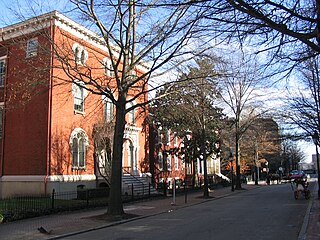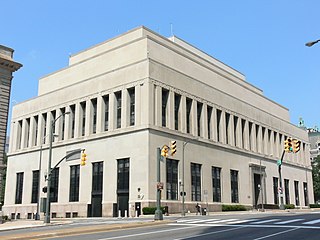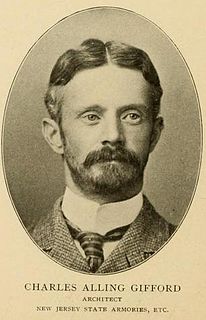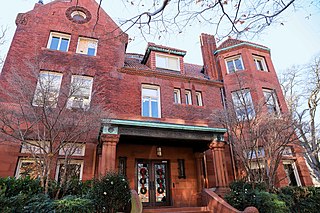
Richmond is the capital city of the Commonwealth of Virginia in the United States. It is the center of the Richmond Metropolitan Statistical Area (MSA) and the Greater Richmond Region. Richmond was incorporated in 1742 and has been an independent city since 1871. As of the 2010 census, the city's population was 204,214; in 2020, the population had grown to 226,610, making Richmond the fourth-most populous city in Virginia. The Richmond Metropolitan Area has a population of 1,260,029, the third-most populous metro in the state.

Broad Street is a 15-mile-long (24 km) road located in the independent city of Richmond, Virginia, and adjacent Henrico County. Broad Street is significant to Richmond due to the many commercial establishments that have been built along it throughout Richmond's history. From downtown through miles into the suburbs, the street is largely dedicated to retailing and offices, including regional and neighborhood shopping centers and malls.

The Library of Virginia in Richmond, Virginia, is the library agency of the Commonwealth of Virginia. It serves as the archival agency and the reference library for Virginia's seat of government. The Library moved into a new building in 1997 and is located at 800 East Broad Street, two blocks from the Virginia State Capitol building. It was formerly known as the Virginia State Library and as the Virginia State Library and Archives.
The Richmond Arena was a multipurpose indoor sports facility located in and owned by the city of Richmond, Virginia. It was located south of Parker Field, between Boulevard and Hermitage Road.

Shockoe Bottom is an area in Richmond, Virginia, just east of downtown, along the James River. Located between Shockoe Hill and Church Hill, Shockoe Bottom contains much of the land included in Colonel William Mayo's 1737 plan of Richmond, making it one of the city's oldest neighborhoods.

Shockoe Slip is a district in the downtown area of Richmond, Virginia. The name "slip" referred to a narrow passageway leading from Main Street to where goods were loaded and unloaded from the former James River and Kanawha Canal. The rough boundaries of Shockoe Slip include 14th Street, Main Street, Canal Street and 12th Street.

Once a leading hotel in downtown Richmond, Virginia, the Hotel Richmond overlooks the Thomas Jefferson designed State Capitol in Capitol Square. One of the rare gilded-age hotels built by a woman entrepreneur, the Hotel Richmond is now owned by the Commonwealth of Virginia, which uses it as its Barbara Johns Building, currently housing the Office of the Attorney General.

Court End is a neighborhood in Richmond, Virginia, that sits to the north of the Capitol Square and East Broad Street. It developed in the Federal era, after Virginia's capital moved from Williamsburg.

Old City Hall, known formerly as City Hall, is the former city hall of Richmond, Virginia that was designed by Elijah E. Myers. It served as City Hall from its completion in 1894 through the 1970s. The building occupies its own city block in downtown Richmond, bounded by 10th and 11th Streets to the west and east, and Capitol Street and East Broad Street to the south. The building is executed in a meticulous Gothic Revival style, and was designated a National Historic Landmark for its architecture.

John McArthur Jr. (1823–1890) was a prominent American architect based in Philadelphia. Best remembered as the architect of the landmark Philadelphia City Hall, McArthur also designed some of the city's most ambitious buildings of the Civil War era. Few of his buildings survive.
Main Street is a major north–south thoroughfare in Los Angeles, California. It serves as the east–west postal divider for the city and the county as well.

William Lee Stoddart (1868–1940) was an architect best known for designing urban hotels in the eastern United States. Although he was born in Tenafly, New Jersey, most of his commissions were in the South. He maintained offices in Atlanta and New York City.

The Patrick Henry Building is a historic building located in Richmond, Virginia. Formerly designated simply as the Old State Library or the Virginia State Library and Archives and Virginia Supreme Court, it was renovated, then rededicated and renamed for the Founding Father and former Virginia Governor Patrick Henry on June 13, 2005.

Charles Alling Gifford was an American architect and a partner in the New York City firm of Gifford & Bates. He is best remembered for his resort hotels, but also designed houses, churches, and five armories for the New Jersey National Guard.

In British usage, the term townhouse originally referred to the town or city residence, in practice normally in London, of a member of the nobility or gentry, as opposed to their country seat, generally known as a country house or, colloquially, for the larger ones, stately home. The grandest of the London townhouses were stand-alone buildings, but many were terraced buildings.

Ginter House is the historic 1892 former residence of Lewis Ginter. It is on the Virginia Commonwealth University (VCU) campus. It was used as Richmond's first public library from 1925 until 1930, was used as part of a school, and was the main administrative building on the Monroe Park, Virginia campus of VCU for more than 40 years.

Shockoe Valley is an area in Richmond, Virginia, just east of downtown, along the James River, and is the entertainment center of the city. Located between Shockoe Hill and Church Hill, Shockoe Valley contains much of the land included in Colonel William Mayo's 1737 plan of Richmond, making it one of the city's oldest neighborhoods. Shockoe Valley encompasses the smaller neighborhoods of Shockoe Slip, Shockoe Bottom and Tobacco Row along Cary Street.
The following is a timeline of the history of the city of Norfolk, Virginia, United States.
Frye and Chesterman was an American architectural firm formed in 1900 by partners Edward Graham Frye (1870–1942) and Aubrey Chesterman (1874–1937) with offices in Lynchburg, Virginia. In 1913 the firm moved to Roanoke, Virginia.

The Freedman's Bank Building, previously known as the Treasury Annex, is a historic office building located on the corner of Madison Place and Pennsylvania Avenue NW in Washington, D.C. It sits on the east side of Lafayette Square, a public park on the north side of the White House, and across from the Treasury Building. The adjoining properties include the Howard T. Markey National Courts Building to the north and former Riggs National Bank to the east.
















